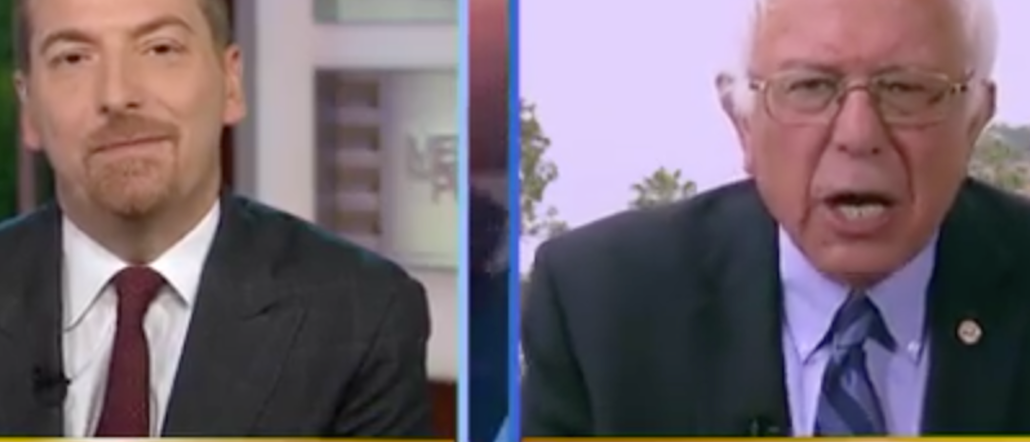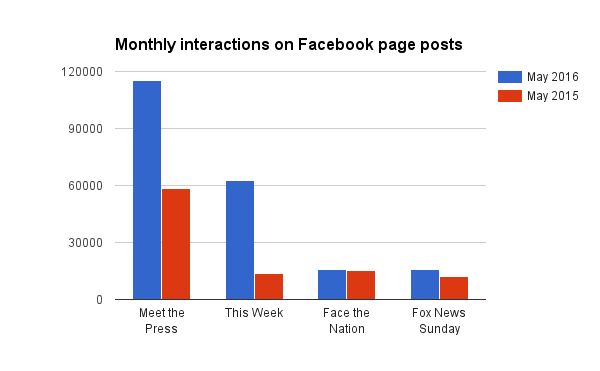
For years, it was enough for the Sunday political talk shows to own the conversation for a single day on television. But if they want to reach young people who are getting their news on Facebook, they have to own social media around the clock, too.
NBC’s “Meet the Press” realized this two years ago when it brought on senior producer Shawna Thomas to overhaul the show’s approach to digital media.
“When I first came on board, the site traffic would spike on Sunday, but then there was a precipitous drop and it didn’t come back till [the next] Sunday,” said Thomas, who was a news producer at NBC several years before her current position. “They would push on Sunday and no one would think to put anything out throughout the week. That is not how news works anymore. We realized we needed to work harder to make Meet the Press a 24-7 brand.”
Thomas has focused on Facebook, the biggest social network, which is where “Meet the Press” has its biggest following. “Meet the Press” started doing Facebook Q&As in which the show’s host Chuck Todd answers questions from the audience, occasionally using Facebook Live. On average, 829 people tune in to the Q&As. On Sunday after the show airs, “Meet the Press” posts a 2-minute video distillation called “Compressed,” which have been averaging 53,500 views each.
Todd runs a separate digital political news unit, which also was rebranded as “Meet the Press,” giving the brand another outlet to grow its awareness.
The results have been dramatic: While “Meet the Press” viewership has declined over the years (though it’s improved lately and was in spitting distance of CBS News’ “Face the Nation” in May), its Facebook following has more than doubled to 321,297 as of May, well ahead of its closest competitor, “Fox News Sunday,” which has 200,965 fans, according to Socialbakers. “Meet the Press” is posting an average of 281 times a month, up from 50 times two years ago, according to the show’s internal numbers. Total monthly interactions on those posts have soared, too, to more than 115,000 as of May from less than 15,000 two years ago.

“Meet the Press” isn’t alone among the Sunday political talk shows in trying to use social media to connect with an audience in between broadcasts. CNN’s “State of the Union” uses social media to promote the show starting Friday and then push out clips, repackaged for Facebook with text overlay. “The main thing about ‘State of the Union’ is we don’t look at it as a standalone TV event,” said CNN’s social media head Samantha Barry. “It’s not just a Sunday play for us.” “Fox News Sunday” has been soliciting viewer questions during the week, live-tweeting the show and running clips during the week of host Chris Wallace’s other journalistic activities, said Jessica Loker, executive producer for the show.
Facebook and Twitter are the primary platforms shows use reach social audiences; they’re still figuring out how to translate their hard-news brands to the more playful, visual platforms like Snapchat and Instagram. CNN’s “State of the Union” has a segment, “State of the Cartoon-ion,” in which host Jake Tapper draws political cartoons, which are posted to Instagram. Fox uses Vine and Instagram to show what goes on behind the scenes on set, but hasn’t ventured into Facebook Live or Snapchat. “Meet the Press” has dabbled with Facebook Live, but hasn’t figured out the best way to use it that doesn’t duplicate what it’s doing on TV.
“Figuring out how to make what we do work on digital and social without the aid of puppies and small children is still tough for me, but what I think we have going for us is that it’s not an afterthought,” Thomas said.
It’s also hard to know if all these efforts on social media translate to viewership because of the difficulty tracking people from one medium to the other. And while the appeal of social media is that it has a younger audience that the Sunday shows want to recruit, that audience also is less likely to be deliberately seeking out news. They’re less aware of the shows in the first place than their older counterparts and more likely to be getting their news from comedy shows. In 2012, 10 percent of the Sunday shows’ audience was age 18-29, compared to 43 percent for Colbert Report, per the Pew Research Center.
“Millennials are less aware of news sources and for a program that’s more niche and built around a program time, it may be more difficult to find those individuals in the first place,” said Amy Mitchell, director of journalism research at the Pew Research Center.
Images from Meet the Press via Facebook.
More in Media

Digiday Scorecard: Publishers rate Big Tech’s AI licensing deals
Digiday has compiled a scorecard grading AI platforms to make sense of the growing number of players in the AI content licensing market.

Publishers are hunting for AI prompt data — now they’re starting to get it from third-party companies
Publishers are finally gaining some visibility into AI search, as new prompt data tools crack open a black box.

Digiday+ Research: Publishers’ growing focus on video doesn’t translate to social platforms
Major publishers have made recent investments in vertical video, but that shift is not carrying over to social media platforms.





